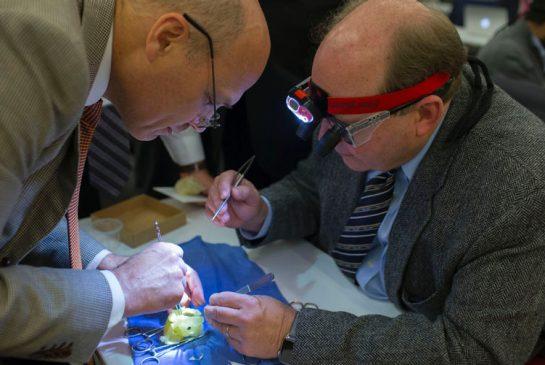Toronto’s Hospital for Sick Children: Doctors Design Patient-Specific 3D Printed Heart Models for Complex Surgical Training
 Just imagine the pressure of being in an operating room, holding the life of a child in your hands, with family members to answer to, as you proceed with an intricate surgery on a delicate and tiny heart. Surgeons normally train for years before they are allowed into an operating room to participate or lead in complex procedures. And materials for that training are a big consideration, and have been a constant concern since the inception of formal medical education.
Just imagine the pressure of being in an operating room, holding the life of a child in your hands, with family members to answer to, as you proceed with an intricate surgery on a delicate and tiny heart. Surgeons normally train for years before they are allowed into an operating room to participate or lead in complex procedures. And materials for that training are a big consideration, and have been a constant concern since the inception of formal medical education.
From practicing for procedures on everything from garden vegetables to each other, the lengths medical students will go to for trying to find something realistic before going on to real live humans has been well documented and often has an almost comical bend. But over the years, more and more incredibly complex surgeries have been completed with success–and as medicine has evolved, so have the training materials. As 3D printing has entered the scene, however, not only has the texture of practice materials changed, but with digital design, incredibly realistic models can be made and customized for specific and difficult surgeries that may have never before been attempted.
 Currently there is a new program for developing and using training materials at the Hospital for Sick Children (SickKids) in Toronto. They are employing 3D printing to create realistic models of the heart, with the replicas being specific to real patient cases. Radiology data is used to create the models, which allow surgeons to practice for rare procedures. It’s hoped that these models will be able to help surgeons worldwide in the future as well.
Currently there is a new program for developing and using training materials at the Hospital for Sick Children (SickKids) in Toronto. They are employing 3D printing to create realistic models of the heart, with the replicas being specific to real patient cases. Radiology data is used to create the models, which allow surgeons to practice for rare procedures. It’s hoped that these models will be able to help surgeons worldwide in the future as well.
In a program created by Dr. Glen Van Arsdell, the head of cardiovascular surgery at the Hospital for Sick Children, and Dr. Shi-Joon Yoo, a cardiac radiologist at SickKids, they use scans from infant patients and then 3D replicas of their hearts. The materials, while not exactly the same texture obviously, are a bit more difficult to work with than an actual organ, but the doctors see that challenge as a good thing in the end.
“The best available material is what we use now . . . my surgeon says it’s a little more difficult (the work on the fake hearts) than (the work) he can do on the real patient,” Dr. Yoo said. “You practice it here, and in the patient, it’s easier.”
While practicing, doctors are able to cut, sew, and operate, mimicking a real surgery–with all the learning and none of the stress.
Practicing for heart surgery is generally not easy, as materials must come either from those who have died and donated their organs, or the samples must come from animals, and are not easy to come by.“It’s not exactly like human tissue, but it works for training,” says Dr. Yoo.
“This is just a much more rapid way of expanding your circle of competence,” said Dr. Yoo.
Both surgeons involved in the new training program are excited for what the future holds regarding the potential 3D printing has for surgical preparation. Medical students and doctors often have to wait more than a decade to participate in difficult heart surgeries, and the sooner they can start practicing, the better.
“There are certain types of valves that are enormously complex, and you’re in a discovery process in the operating room in terms of how to fit them. I think that’s the next step . . . we’ll print a specific valve, rehearse the operation and come up with a plan we want, and then go to the operating room,” said Dr. Van Arsdell.
“We’re at the very early stages (with 3D printing), but already it’s quite a change from even a year ago.”
With 3D printing materials being improved on continually, there’s definitely a bright future for taking this program even further, and Yoo definitely sees a bright future for bioprinting and implants, in terms of cardiac medicine and surgery. The technology is new, but they are optimistic that it will be opening many new doors in just a few years. For now, the benefits are already substantial, as they are able to make models at relatively little cost that allow them to get started right away in practicing. Discuss this story in the 3D Printed Heart Model forum on 3DPB.com.
[Source: Toronto Metro News]Subscribe to Our Email Newsletter
Stay up-to-date on all the latest news from the 3D printing industry and receive information and offers from third party vendors.
You May Also Like
3D Printing Financials: Fathom Struggles in Financial Quicksand During Critical Transition
Facing a year of key transitions and financial pressures, Fathom (Nasdaq: FTHM) has filed its annual report for 2023 with the U.S. Securities and Exchange Commission (SEC). The document outlines...
Latest Earnings Overview for Australian 3D Printing Firms Titomic and AML3D
Australian 3D printing manufacturing firms Titomic (ASX: TTT) and AML3D (ASX: AL3) reported their financial results for the period from July to December 2023, marking the first half of their...
3D Printing Webinar and Event Roundup: April 7, 2024
Webinars and events in the 3D printing industry are picking back up this week! Sea-Air-Space is coming to Maryland, and SAE International is sponsoring a 3D Systems webinar about 3D...
3D Printing Financials: Unpacking Farsoon and BLT’s 2023 Performance
In the Chinese 3D printing industry, two companies, Farsoon (SHA: 688433) and Bright Laser Technologies, or BLT (SHA: 688333), have recently unveiled their full-year earnings for 2023. Farsoon reported increases...
































